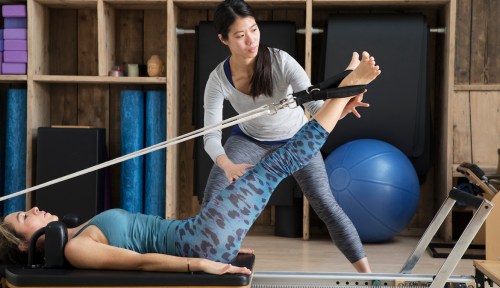Our editors independently select these products. Making a purchase through our links may earn Well+Good a commission
What a Pilates Instructor Wants You To Know Before Going to Your First Pilates Reformer Class—Because That Thing Can Be Intimidating
A Pilates instructor breaks down what Pilates reformer classes are like so you can enter the studio confidently.

Starting a new form of exercise is always nerve-wracking—especially when it involves seemingly complex equipment like a Pilates reformer. But as Pilates grows increasingly popular because of its many benefits (better posture, flexibility, balance, and more!), you might be wondering what all the fuss is about. That’s why we asked New York-based instructor Jennifer Kreichman to share what you need to know to take your first class with confidence.
Experts in This Article
Pilates instructor based in New York City
First, some background
Pilates was developed by German bodybuilder Joseph Pilates during World War I. According to Pilates lore, while interned by the British as a German enemy alien, Pilates used his time to explore new forms of exercise, and teach his fellow internees. Near the end of the war, it’s said that he worked as an orderly in a hospital, and experimented with the springs attached to hospital beds, using their resistance to strengthen his patients’ muscles. Thus the reformer was born.
Today, the apparatus looks similar to a bed, with a platform (carriage) in the center that rolls back and forth. Participants push and pull their body along this track with various bars and straps. Adjustable springs at the bottom allow users to increase or decrease the resistance.
“It’s a form of exercise that incorporates the mind and the body,” Kreichman says. “It balances strengthening exercises, flexibility, range of motion, and, as individuals become more advanced, aerobics.”
The difference between reformer and mat Pilates
Pilates can either be done on a mat or the reformer, and each offers a different challenge. “When working on the mat, you are using your own physicality against the pull of gravity,” Kreichman says. “On the reformer, the springs take that resistance created by gravity, and add to it so you can execute a greater range of movement.”
Though they both follow a flow progression (there’s a standard way to do class from one exercise to another, like a ballet class), the two flows are not identical. “They’re related,” Kreichman says. “Any exercise we do on the reformer has similarities to exercises we do on the mat, but they are not the same.”
When asked if one is better than the other, Kreichman says that your best bet is to do both, if you can: “They have different benefits, and if you can be exposed to all of it (the reformer, the mat, and other apparatuses like the Cadillac, and the chair) you experience Pilates as it was initially developed.”
Common misconceptions
“Some people think Pilates is only for women, older people, those with injuries, or dancers,” Kreichman says. “At any age, everyone can benefit from increasing strength, flexibility, and range of motion. If you do it when you’re young, it will protect your spine and the rest of your body as you get older. You will be able to stand up straight and prevent injury. Those benefits are not gender- or age-specific.”
Some people also assume the low number of repetitions make Pilates a less effective workout than other options. “My daughter’s boyfriend recently attended my class for the first time, and he was very interested in why we did a certain exercise just four times,” she says. “He didn’t want to stop until he got the movement correct, and when he finished his back really hurt. That right there is one of the reasons we do a limited number of repetitions.” Many exercise modalities use specific muscle groups until they burn out or fatigue. “Pilates has a more holistic approach,” Kreichman says. “You do fewer repetitions, but you target a wider range of muscle groups. The idea is you don’t need all those reps to get stronger, particularly if you execute each exercise mindfully.”
How to approach your first class
Reformer Pilates has a steep learning curve. The slide of the carriage is a new sensation for many people, and there are quite a few safety/technical rules to grasp. (For example, you should always put your headrest down before doing short-spine exercises.) “These are things you can only learn by taking a class,” Kreichman says. “Ultimately, the only real mistake you can make on your first day is throwing yourself into the exercises without closely watching and listening to your teacher’s instructions.”
Kreichman recommends novice reformer Pilates students tell their instructor about any current or previous injuries or health concerns. She also wants you to be open-minded. “Remember that it takes time to learn something new, so don’t be discouraged if the physical vocabulary doesn’t come naturally at first,” she says.
Know that the goal of this class is not for you to be in pain the next day. “You really shouldn’t be super sore after reformer Pilates,” Kreichman says. “The goal is for you to have improved structural alignment, and to feel stronger.”
Want to try a reformer-like workout at home without a reformer? Try this series using a foam roller:
Sign Up for Our Daily Newsletter
Get all the latest in wellness, trends, food, fitness, beauty, and more delivered right to your inbox.
Got it, you've been added to our email list.










